Introduction
The Redmi phones is where it all started for Xiaomi and the series is still by far the company's most important. It grew immensely over the years, with the highest standing members able to trade blows with some of the most powerful flagships out there. Yet the pure Redmi phones always stuck to the same formula - deliver solid smartphone experience at the tightest budget possible thus maximizing the value for money.
The new Redmi 9 is arguably standing closer to the its Note counterpart - the Redmi Note 9 - than any of its predecessors. It has the same large 1080p screen and a very similar MediaTek chipset, and even if the cameras have seen some downgrades they cover the same focal lengths, offering mostly the same sort of versatility.

This has helped bring the price down to just over €120 - or about 10% of what an iPhone 11 Pro Max costs. Quite tempting when you consider that the Redmi 9 finally makes the switch to a 1080p screen and offers a large battery that should last you for days.
Before we unbox the Redmi 9 let's take a closer look at its key specs.
Xiaomi Redmi 9 specs
- Body: 163.3 x 77 x 9.1 mm, 198g; Gorilla Glass 3 front, plastic back and frame.
- Screen: 6.53" IPS LCD, 1080 x 2340px resolution, 19.5:9 aspect ratio, 395ppi.
- Chipset: MediaTek Helio G80 (12nm): Octa-core (2x2.0 GHz Cortex-A75 & 6x1.8 GHz Cortex-A55); Mali-G52 MC2 GPU.
- Memory: 3GB/4GB/6GB RAM, 32GB/64GB/128GB storage, dedicated microSD slot.
- OS/Software: Android 10, MIUI 11 (MIUI 12 update coming soon)
- Rear camera: Main: 13MP, f/2.2 aperture, 1/3.1" sensor, 1.12µm pixel size, 28mm equiv., PDAF. Ultrawide-angle: 8MP, f/2.2, 1/4.0" sensor, 1.12µm pixels, fixed focus; Macro: 5MP, f/2.4, AF; 2MP depth sensor.
- Front camera: 8MP, f/2.0, 1.12µm.
- Video recording: Rear camera: Full HD 1080p@30fps. Front camera: Full HD 1080p@30fps.
- Battery: 5,020 mAh, 18W fast charging (10W charger included)
- Misc: NFC (market dependent); wireless FM radio, rear-mounted fingerprint reader, IR blaster;
That reveals another thing missing from the Redmi Note 9 - the water-repelling coating. That's hardly going to be held against the Redmi 9, though, as it's hardly a feature to expect in the entry level segment. And it's not like the Note 9 had an IP rating either so you'd still better be careful around the pool.
Unboxing the Redmi 9
The Redmi 9 is a budget phone, but you still get a transparent case in its retail package that fits well around the Redmi 9. The phone also has a pre-applied rather cheap screen film for some extra scratch protection, but it was a massive smudge magnet and we got rid of it fast.

We do appreciate the protective case, but you should know that it comes with a sealing cap for the connectivity port. And while it provides for some water protection, it was rather irritating having to remove it every time we had to recharge the Redmi 9.
The entry level nature of the phone is betrayed by the 10W charger in the box, despite it supporting 18W charging. If you want to maximize that potential you'll have to get a charger of your own, but if you are going to be overnighting it anyway it hardly makes a difference. And the phone has the current USB-C port so you might even have a suitable charger at hand.
Design, build, handling
The Redmi 9 may be one of the most affordable smartphones around, but it certainly doesn't look cheap. The new Redmi looks quite attractive, comes with a pleasant texture on the back, while the large screen has rather thin bezels. Overall, everything looks better than what the price might suggest.

The Redmi 9 is a relatively large and thick phone, but that is unavoidable given the 6.53" display and the beefy 5,020 mAh battery within. Still, at about 200g the Redmi 9 doesn't feel overweight, in fact it about what you'd expect given its footprint and thickness.

The 6.53" IPS LCD 1080p panel has rounded corners as usual and occupies almost the entire front. It has a waterdrop notch for the 8MP selfie camera. The earpiece grille is very thin and almost invisible between the glass and the frame. Unfortunately, there is no notification LED light on the Redmi 9.

The display is protected by a flat piece of Gorilla Glass 3, but Xiaomi is also shipping the Redmi 9 with a thin (and rather cheap) screen protector. It might do for a month or two, but if you feel you need the extra protection, then you should buy a proper one and replace it.
The Redmi 9 has no frame per se as its rear panel envelops everything that is not screen - something we once called unibody. The whole piece is made of thick and sturdy plastic, but the maker has applied different finish on the back and the sides, so you can feel where the "frame" ends, and the back begins.

There are no glossy bits on the Redmi 9's back panel - the sides have matte finish, while the rear part features the nice and grippy fingerprint-like texture. The pattern ends around the camera setup, which reminds us of the more premium Redmi K30.
We have the Sunset Purple version of the Redmi 9 and you can see the cool transition from blue to purple on the back. The gradient even extends to the sides, making up for a really nice look.

The camera is protruding just a little bit, but nothing that could compromise the experience. Three of the four snappers are vertically aligned within a single black glass - the 8MP ultrawide, the 13MP primary, and the 2MP depth sensor. Below those three is the always-on (and very accurate) fingerprint reader.
The single LED flash and the 5MP macro camera get their own small island on the side.

Now, let's take a look at what's on the sides of the Redmi 9. We'll start with the bottom, which is the busiest bit - here you'll find the speaker, the mouthpiece, the USB-C port and the 3.5mm jack.

The right side of the Redmi 9 contains the volume and power keys, the left has the triple card slot (so you can insert a microSD card and two SIM cards), and the top houses the IR blaster and the second mic.

Unlike the Redmi Note 9 series, the Redmi 9 lacks any sorts of water protection - be it rubber seals or nano coating. So you better be extra careful not to get any of the openings wet.
Handling the Redmi 9 is a great experience - it is one very grippy phone and fits very well in a hand. It feels secure no matter the orientation, and overall, we had no issues while using it. Thanks to the all-matte finish, fingerprints and smudges rarely stick and are hard to be seen.

Xiaomi is providing a silicone case if you want additional protection for your new Redmi 9. It is your typical transparent case, but it does come with a cap for the USB-C port, which is a nightmare to open each and every time you want to charge the Redmi 9. We'd rip it off, but maybe that's just us.
Display
The Redmi 9 features a large 6.53" IPS LCD with a waterdrop-shaped notch at the top to make room for the selfie camera. The resolution is extended 1080p - 2,340 x 1,080 pixels - making for a 395ppi density.
It is quite rare to see a 1080p screen on a budget device and the Redmi 9 is probably among the few cheap phones to offer it.

The display is protected with a Gorilla Glass 3, but this Redmi also ships with a thin screen protector that's been applied in the factory.
The Redmi 9 screen omits support for HDR10, wide-gamut color is not available, too. The phone has Widevine L1 DRM support though and you will be able to enjoy 1080p content from all popular streaming apps.
Xiaomi promises 1500:1 contrast ratio for the Redmi 9 screen, and our measurements show it is in the ballpark of the promised value.
Unfortunately, the maximum brightness is poor for an LCD at about 330 nits. However, the screen can go brighter if you leave it on Automatic Brightness - it can light up as high as 420 nits in bright ambient light - not much of an improvement, but that's about what Xiaomi is promising in the official specs, so not that of a surprise.
The minimum brightness we recorded on the white color is 1.4nit - a perfect one for reading sessions in the dark!
| Display test | 100% brightness | ||
| Black, |
White, |
||
| 0.202 | 328 | 1624:1 | |
| 0.253 | 426 | 1684:1 | |
| 0.303 | 421 | 1389:1 | |
| 0.42 | 575 | 1369:1 | |
| 0.298 | 370 | 1242:1 | |
| 0 | 466 | ∞ | |
| 0.331 | 450 | 1360:1 | |
| 0.453 | 600 | 1325:1 | |
| 0.328 | 528 | 1610:1 | |
| 0.317 | 408 | 1287:1 | |
| 0.384 | 491 | 1279:1 | |
| 0.345 | 485 | 1406:1 | |
| 0.345 | 487 | 1412:1 | |
| 0 | 379 | ∞ | |
| 0 | 520 | ∞ | |
| 0.425 | 461 | 1085:1 | |
| 0.501 | 515 | 1028:1 | |
Xiaomi offers three different Contrast settings for the Redmi 9 display. With the Automatic contrast set to on, the screen has mediocre accuracy in the sRGB color space - we measured an average deltaE of 6.7 and maximum deviation of 15.1. Only in this mode, you can choose the color saturation (default, warm, cool) and the deltaE of 6.7 was measured with the Default preset. Choosing warm will diminish the massive blue tint and will lower the average deltaE to 5.2.
The Standard Contrast setting has somewhat better accuracy within the sRGB color space, and we recorded an average deltaE of 4.5 - still not a great one but it does help reducing the blue tint more.
Finally, the Increased Contrast makes the colors pop at the expense of reproduction accuracy.
Battery life and charging
The Xiaomi Redmi 9 is powered by a large 5,020mAh Li-ion battery. It supports 18W quick charging, but it only ships with a 10W adapter. Using the charger in the box will get a flat battery up to 20% in 30 mins - far from impressive. If you purchase an 18W (or more) USB-PD compatible adapter, you can get about 33% of the Redmi 9's battery filled in half an hour.
The Redmi 9 scored an outstanding endurance rating of 131 hours in our battery life test. The phone shows impressive times across the board - talk time, video playback and web browsing, as well as standby.
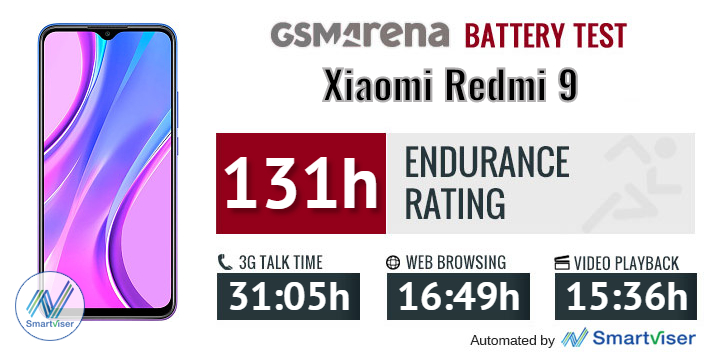
Our battery tests were automated thanks to SmartViser, using its viSerDevice app. The endurance rating above denotes how long a single battery charge will last you if you use the Xiaomi Redmi 9 for an hour each of telephony, web browsing, and video playback daily. We've established this usage pattern so that our battery results are comparable across devices in the most common day-to-day tasks. The battery testing procedure is described in detail in case you're interested in the nitty-gritty. You can check out our complete battery test table, where you can see how all of the smartphones we've tested will compare under your own typical use.
Speaker
The Redmi 9 has no special treatment for its loudspeaker. It is a single bottom-firing unit and tuned mostly for mid-tones. It posted a 'Good' result for loudness in our seven-track music test. It lacks a low-frequency thump, but it handles vocals decently.
Use the Playback controls to listen to the phone sample recordings (best use headphones). We measure the average loudness of the speakers in LUFS. A lower absolute value means a louder sound. A look at the frequency response chart will tell you how far off the ideal "0db" flat line is the reproduction of the bass, treble, and mid frequencies. You can add more phones to compare how they differ. The scores and ratings are not comparable with our older loudspeaker test. Learn more about how we test here.
MIUI 11 on top of Android 10, MIUI 12 is in the works
Xiaomi Redmi 9 runs on MIUI 11 that's based on the latest Android 10 OS. Xiaomi is already adding finishing touches to the MIUI 12 so the update should begin popping on Redmi 9 phones around the globe in August 2020.

You can unlock the screen via the rear-mounted fingerprint scanner. The reader is easy to set up and works fast. The accuracy is superb, too, and overall, it is excellent for your daily unlocking.
The Redmi 9 supports Dark mode - it will switch all system colors from white to black. With MIUI 11 most of the apps support Dark mode, and the icons and their colors have altearnative designs to suit it better.
An app drawer is not enabled by default in MIUI, you can opt for it from the Homescreen settings, though.
Here are the default home screens on Redmi 9. There's a weather widget in the upper right corner across from a large clock widget. There is a Google pane, the leftmost one.
MIUI 11 has refined looks with less clutter, and you easily spot the Xiaomi efforts towards minimalistic design in the new Settings app.





Lockscreen • Homescreen • Homescreen • Tools • Google Discover
The task switcher has not changed much. It shows all of your recent apps in two columns. Tap and hold on a card for the split-screen shortcut, or just swipe it left or right to close it.




Notifications • Toggles • Recents • Split Screen
Themes are supported on the Redmi 9 and if that's your thing there's no shortage of options.
MIUI also offers a Security app. It can scan your phone for malware, manage your blacklist, monitor or restrict your data usage, configure battery behavior, and free up some RAM. It can also manage the permissions of your installed apps and allows you to define the battery behavior of selected apps and applies restrictions only to the apps you choose.
MIUI also offers proprietary Gallery, Music, and Video player. In some regions, the music and video apps come complete paid streaming options.
An FM radio app is available as well. The Redmi 9 has an integrated radio antenna and does not require headphones to act as one. The radio signal is rather poor with the internal antenna though, so when possible, you'd better enhance it with a pair of headphones.
MIUI 11 has a proprietary document viewing app, which supports all popular formats and makes easier viewing docs on your phone. There is also a dedicated Notes app with support for Tasks.






Security app • Security app • Gallery • File Manager • Mi Remote • FM radio
In some markets, the pre-installed applications by Xiaomi will show ads, which is how Xiaomi is compensating for the relatively lower prices of its devices. We are reviewing the global version of the Redmi 9, and the only places we noticed ads were the File Manager and the Security apps. Those, while pre-installed MIUI apps, are not essential and there are ways to get rid of them.
Sadly, not all is great with MIUI on the Redmi 9. The experience was not exactly "smooth," and we had a couple of choppy animations and delays here and there. It was not the prevalent behavior, but we felt it's important to share. It appears that the software needs better optimization as the Helio G80 chipset should have enough in it to drive the UI smoothly.
Performance and benchmarks
Redmi 9 employs the MediaTek Helio G80 SoC. This is pretty much the same chip as the Helio G85 within the Redmi Note 9 and the only difference is the GPU clock.
So, the Helio G80 has an octa-core processor with 2x Cortex-A75@2.0GHz cores and 6x Cortex-A55@1.8GHz units.
The G80 chip has dual-core Mali-G52 GPU clocked at 950MHz. The Redmi Note 9's G85 has its GPU ticking at 1000MHz.
The Redmi 9 can be purchased in three different configurations - 3GB RAM + 32GB storage, 4GB RAM + 64GB storage (our review unit), and 6GB RAM + 128GB storage.

The G80 processor is perfectly fine for this budget class and does not disappoint in benchmark performance.
GeekBench 5.1 (multi-core)
Higher is better
- Xiaomi Redmi Note 9S
1785 - Sony Xperia 10 II
1413 - Realme 6i
1349 - Xiaomi Redmi 9
1325 - Xiaomi Redmi Note 9
1292 - Samsung Galaxy A31
1216
GeekBench 5.1 (single-core)
Higher is better
- Xiaomi Redmi Note 9S
570 - Realme 6i
388 - Xiaomi Redmi 9
362 - Xiaomi Redmi Note 9
361 - Samsung Galaxy A31
352 - Sony Xperia 10 II
315
Unfortunately, the GFXBenchmark and 3D Mark couldn't run on the Redmi 9, just as they refused to run on the Redmi Note 9. If you are curious about the raw performance of the dual-core Mali-G52, the Realme 6i has the same Helio G80 chip and we can safely guess the Redmi 9 will be in the same ballpark.
GFX 3.1 Car scene (1080p offscreen)
Higher is better
- Xiaomi Redmi Note 9S
18 - Realme 6i
9.4 - Samsung Galaxy A31
8 - Sony Xperia 10 II
7.1 - Samsung Galaxy A30
4.5 - Xiaomi Redmi 8A
3.5
The AnTuTu 8 test returned an excellent score for this class and the Redmi 9 is bested only by the more expensive (and powerful) Redmi Note 9S.
AnTuTu 8
Higher is better
- Xiaomi Redmi Note 9S
254000 - Realme 6i
202275 - Xiaomi Redmi 9
201829 - Xiaomi Redmi Note 9
200414 - Sony Xperia 10 II
196545 - Samsung Galaxy A31
151815 - Xiaomi Redmi 8A
89901
Long story short, the Redmi 9 is capable enough phone, but it will not offer perfectly smooth UI experience, while its 1080p screen might be too much for the GPU to handle. It will run lighter games and you can even go for popular action titles by lowering the screen resolution, but it will not be peachy, nor particularly sharp.
Let's not forget that the Redmi 9 is one cheap budget phone, so nobody expected it to be a gaming champion. It does well with the OS and popular social and office apps, and its camera has more than acceptable processing speeds. That's enough for just over a hundred bucks, we think.
A budget quad-camera
The Redmi 9 camera setup looks a lot like the one we saw on the Redmi K30 - the snappers are in vertically aligned on an elevated pill-shaped island within a circle on the back. The four shooters are what you'd expect from a budget device these days - wide, ultrawide, macro and depth.

The main camera uses a 13MP OmniVision OV13B10 sensor with 1.12µm pixels and 27mm f/2.2 lens. It's the only one to offer autofocus and it's of the regular PDAF variety rather than some fancier technology.
The 118-degree ultrawide-angle camera has an 8MP Samsung S5K4H7 ISOCELL sensor with 1.12µm pixels and a 15mm f/2.2 lens. There is automatic distortion correction applied with no option to disable it.
Then there's the 5MP macro camera with 1.12µm pixels and lens with f/2.4 aperture. Autofocus is not available, you must keep the phone between 3cm and 5cm from your subjects to get them in focus.
The last unit on the back is the 2MP depth sensor.
Swiping left and right will take you through all modes while tapping in the upper right corner of the screen where the "hamburger menu" resides will expand the options. The Macro mode is hidden within this menu, which is a bit odd.
The real settings menu is in there as well, but it offers limited amount of options.
The Redmi 9 has a manual (Pro) mode. It lets you adjust all the settings you'd need - white balance, focus, ISO, and shutter speed. The Pro mode works with the main camera, the ultrawide, and even the macro, although clearly focus settings only apply to the first one.
Image quality
The 13MP photos from the main camera are great for this budget class. They are not the most detailed, nor do they have amazing contrast or dynamic range. However they are doing a decent job in each one of those areas, while maintaining reasonably low noise levels - that's hardly the norm with €130 phones and the Redmi 9 deserves praise for achieving it.
The foliage, even if not the sharpest one, looks very natural and we have to thank the mature processing for it.
The photos below were captured with default HDR set on Auto, but it triggered just once or twice.
The Xiaomi camera app offers the so-called AI mode, which tunes the color depending on the scene recognition. It does add a bit of extra punch to your photos, boosting the color saturation and contrast, but some might find the overprocessed look a bit unnatural.
The camera app has a 2x zoom toggle, and as you can imagine, it's just a digital zoom over the main camera.
Redmi 9's 8MP ultrawide camera is among the better ones we've encountered through the entire budget and midrange segments, and it can even give some premium midrangers a run for their money. The shots have an average amount of detail, while colors are almost as accurate as those from the main camera. The dynamic range is also great for an ultrawide unit, while the frame-stacking triggered when in Auto HDR almost completely removes noise when sufficient light is present.
The distortion correction does a very good job at strengthening wrapped buildings or trees although it does come at the expense of corner sharpness.
The Redmi 9 has a 5MP macro camera, but unlike other Redmi phones, this one has a fixed focus at about 3cm-5cm. If you get the distance right, then you can expect detailed shot of flowers, bugs, cacti, or, say, banknotes.
Finally, the 2MP depth sensor is aimed to improve the faux bokkeh of the portrait mode and it enables decent subject separation, provided the person is not having a messy hair day.
The photos are detailed enough, and the blur is convincing, so if you ever want to shoot portraits and blur the background, you will be happy with what the Redmi 9 can do.
We played a lot with the settings at nighttime and we found out that it is best to leave the AI cam active and the HDR at Auto. This way you get somewhat better colors and some extra preserved highlights, especially at sunset or sunrise.
Still, the 13MP photos taken in low light are nothing special and when it is dark, the camera just struggles to get the exposure correctly. However, when we look at the bigger picture we have to appreciate that the shots are often usable, even if noisy - at the very least for posting on the social networks. Again that's not something you should take for granted in this price range.
The 8MP ultrawide photos at night are noisier and less detailed, but we've seen a lot worse from more expensive phones. We don't recommend using this camera at night, but around sunset and sunrise, it will do an okay job.
Somewhat disappointingly, the Redmi 9 does not support Night Mode.
Here's how the primary camera on the Redmi 9 stacks against the rest of the competition in the controlled environment of our Photo Compare Tool.



Xiaomi Redmi 9 against the Redmi Note 9 and the Realme 6i in our Photo compare tool
Selfies
The Redmi 9 features an 8MP selfie camera with 26mm f/2.0 lens and fixed focus. The detail in the photos is mediocre, but the contrast and colors are okay. Noise is present, and the dynamic range is average at best, though HDR is available and it restores blown parts rather well.
Portrait mode is available for selfies, too, and it is as competent as a single fixed-focus camera can be. If your haircut is not that complex, and you don't mind a smeared ear or two, it might produce passable results.
Video recording
The Xiaomi Redmi 9 captures videos 1080@30fps with its main, ultrawide, and macro cameras. There is no 4K mode, 60fps shooting is not available either.
The video bitrate is 20Mbps, while audio is recorded in mono with a 128Kbps bitrate. There is no support for electronic stabilization on the Redmi 9.
The footage from the main camera is average in detail and with dull colors, but the noise is low, and the dynamic range is rather good.
The 2x zoomed clip from the main camera is quite good. Its detail is a match for the non-zoomed footage, the colors are better saturated, and the contrast is a bit higher, too.
Finally, the ultrawide camera captures videos with better colors and contrast, while the detail remains unimpressive.
Once you are done with the real-life scenarios, take a look at our video compare tool to see how it competes against the other phones we've reviewed.



1080p: Xiaomi Redmi 9 against the Redmi Note 9 and the Realme 6i in our Video compare tool
Wrap-up
The Redmi 9 is an excellent budget phone that seems easy to recommend. It has one large screen perfect for multimedia, shoots great photos, and its battery will last you days no matter what you are doing.

The performance is mediocre, and the screen is hardly usable under bright sunlight, though nobody really should have expected gaming skills from a €130 phone. And yet, gaming is possible if you are okay sacrificing the graphics quality.
Still, for what the Redmi 9 was made for, it delivers, and even goes even beyond expectations here and there, which .
Alternatives
If the Redmi Note 9S can fit in your budget, then it surely is the better alternative. The Note 9S is about €60 more expensive, but it will offer you a better screen, much faster hardware, and improved image and video quality.
If all you need is slightly better quality images and perhaps Night Mode check out the Redmi Note 9. About €45 more expensive than the Redmi 9, it is basically the same phone as the Redmi 9, but with a 48MP primary camera, a 13MP selfie shooter, and faster charging adapter included in the box.
The Realme C3 costs about €140 and is the cheapest phone Realme is selling in Europe right now. It has a 720p screen and slightly lower grade Helio G70 chip, while also omitting the ultrawide camera on the back. For an extra €20 Realme will fix most of these omissions with the Realme 5i, though its screen will remain at 720p resolution. The lower pixel count does help in games, but if social networks and streaming take priority, the Redmi 9 is the better bet.
Huawei has a phone that's priced the same as the Redmi 9, but offers more gaming power - the P40 Lite E. It has a 720p display but with a smaller notch, offers faster hardware, similar camera skills and promising battery life. The only caveat - you'll have to manage without Google Play Services.
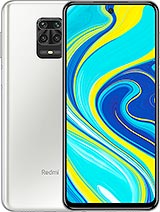
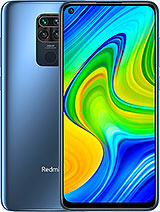
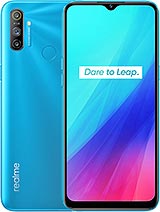
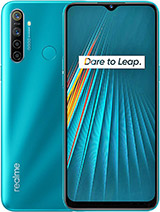
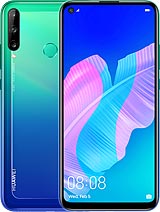
Xiaomi Redmi Note 9S • Xiaomi Redmi Note 9 • Realme C3 (3 cameras) • Realme 5i • Huawei P40 lite E
The verdict
The Redmi 9 is a budget offer that none can quite match at this time. If your budget is around €120 you probably won't find a better phone. With a high-res screen, high-quality camera, and impressive battery life - the Redmi 9 exceeds the expectations.

The Redmi 9 is not that snappy, but it's not bad enough to be a deal-breaker. At this price levels, the performance is as expected rather than disappointing. There are snappier options around, but you'll have to sacrifice screen resolution and likely also battery life and camera quality.
Overall, the Redmi 9 is yet another masterstroke by Xiaomi in the budget segment and if it matches what you want to spend you won't regret getting it.
Pros
- Beautiful and grippy plastic body
- Large, sharp LCD screen with high contrast, GG3
- Remarkable battery life
- Good photo and video quality for the class
- Latest Android
- Wireless FM radio, NFC, 3.5mm jack, microSD, IR blaster
Cons
- Low screen brightness
- Mediocre performance
- Sluggish charging
- Not even basic water protection




















































































0 Response to "Xiaomi Redmi 9 review"
Post a Comment